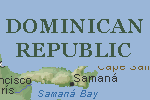Main menu:
Domenican Republic
Introduction |
||
Flag: |
|
|
Card: |
||
Background: |
A legacy of unsettled, mostly non-representative, rule for much of the 20th century was brought to an end in 1996 when free and open elections ushered in a new government. |
|
Geography |
||
Location: |
Caribbean, eastern two-thirds of the island of Hispaniola, between the Caribbean Sea and the North Atlantic Ocean, east of Haiti |
|
Geographic coordinates: |
19 00 N, 70 40 W |
|
Map references: |
Central America and the Caribbean |
|
Area: |
total: 48,730 sq km |
|
Land boundaries: |
total: 275 km |
|
Coastline: |
1,288 km |
|
Climate: |
tropical maritime; little seasonal temperature variation; seasonal variation in rainfall |
|
Terrain: |
rugged highlands and mountains with fertile valleys interspersed |
|
Elevation extremes: |
lowest point: Lago Enriquillo -46 m |
|
Geography - note: |
shares island of Hispaniola with Haiti (eastern two-thirds is the Dominican Republic, western one-third is Haiti) |
|
People |
||
Population: |
8,581,477 (July 2001 est.) |
|
Nationality: |
noun: Dominican(s) |
|
Ethnic groups: |
white 16%, black 11%, mixed 73% |
|
Religions: |
Roman Catholic 95% |
|
Languages: |
Spanish |
|
Government |
||
Country name |
conventional long form: Dominican Republic |
|
Government type: |
representative democracy |
|
Capital: |
Santo Domingo |
|
National holiday: |
Independence Day, 27 February (1844) |
|
Flag description: |
a centered white cross that extends to the edges divides the flag into four rectangles - the top ones are blue (hoist side) and red, and the bottom ones are red (hoist side) and blue; a small coat of arms is at the center of the cross |
|
Economy |
||
Economy - overview: |
The Dominican economy experienced dramatic growth over the last decade, even though the economy was hit hard by Hurricane Georges in 1998. Although the country has long been viewed primarily as an exporter of sugar, coffee, and tobacco, in recent years the service sector has overtaken agriculture as the economy's largest employer, due to growth in tourism and free trade zones. The country suffers from marked income inequality; the poorest half of the population receives less than one-fifth of GNP, while the richest ten percent enjoy 40% of national income. In December 2000, the new MEJIA administration passed broad new tax legislation which it hopes will provide enough revenue to offset rising oil prices and to service foreign debt. |
|
Industries: |
tourism, sugar processing, ferronickel and gold mining, textiles, cement, tobacco |
|
Agriculture - products: |
sugarcane, coffee, cotton, cocoa, tobacco, rice, beans, potatoes, corn, bananas; cattle, pigs, dairy products, beef, eggs |
|
Currency: |
Dominican peso |
|
Currency code: |
DOP |
|
Transportation |
||
Railways: |
total: 757 km |
|
Highways: |
total: 12,600 kmpaved: 6,224 kmunpaved: 6,376 km (1996) |
|
Waterways: |
none |
|
Pipelines: |
crude oil 96 km; petroleum products 8 km |
|
Ports and harbors: |
Barahona, La Romana, Puerto Plata, San Pedro de Macoris, |
|
Coffee |
||
Watch out Sammy Sosa! The Dominican produces more than mild cigars --it has a tradition of coffee production that dates several centuries now. In general Dominican coffees hold true to the soft, mild profile of Island coffees in general. But sometimes they have some real character. If you like clean tasting wet-processed coffees from Central America or Island coffees from the Carribean or Hawaii you should take a Dominican coffee out for a test drive ... |
||
Growing-areas: |
Cibao, Barahona |
|
Qualities: |
Washed Arabicas |
|
Altitude: |
600 - 1500 Meter |
|
Harvest: |
lower altitude = September |
|
Shippingperiod: |
November bis May |
|
Production: |
Barahona, La Romana, Puerto Plata, Santo Domingo |
|
Shipment: |
in container in bags |
|
Production: |
650.000 bags |
|
Export figures: |
99.026 bags |
|
Caffeine content: |
1,37 % |
|
Wet processed HB |
Region: Bani |
Crop 2000 Appearence: 0 d/300gr, 18/18scr |
|
Notes: |
Overall the coffee is mild and soft. It is clear it is an island coffee and not from a super high altitude. That said, there is a lot going on in this cup ...even without a huge aftertaste I get a lot of different flavours here. The main flavour is linked to the acidity: grapes and apples , not fully fermented or fresh --somewhere in between. That may bug some people; some like it. Typical Central America acidity is judged for clarity, like ringing a bell: here the bell is rung but with your other hand on it the sound is muted. There are also hints of vanilla and spice (allspice) that lurk behind the fruit. Haitian coffee is the original new world coffee, I imagine this Dominican is what the folks woke up to in the Americas circa 1700! |
Roast: |
Full City - Vienna -French . I like the caramel-apple flavour I get from the lighter roast of this coffee, but there is a sourness in the acidity that some might not like. It turns to a very nice sharp pungency in the darker roasts though, which makes this a popular choice for those with Vienna / French Roast tendencies. |
Compare to: |
Fruity like some Central Americans, mild and simple like Island coffees |












